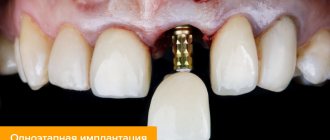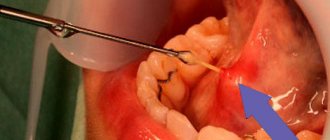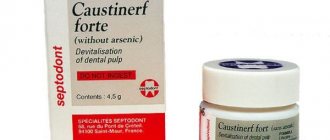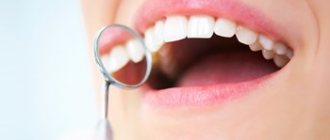Use of arsenic in dentistry
The paste, which is based on the oxide of this poison, has a destructive effect. Therefore, it can be used before removing the nerve. What are the properties of the paste?
- It has a fairly high degree of toxicity;
- It acts as a pain reliever;
- The mixture has a pronounced antibacterial effect;
- Its action is prolonged;
After a day or two, arsenic kills the nerve in the tooth. Patients with a low pain threshold do not feel pain during extraction of such a masticatory organ. It happens that the operation is performed after an injection with an anesthetic substance. Most often, the mass is laid for 1-2 days. The duration depends on the complexity of the pathology of the unit. It is extended when the multi-channel unit is disturbed.
To determine the duration of action of the drug, the doctor takes into account its composition. As a rule, more than half of the paste consists of anesthetic components and anhydride, which has a necrotic effect. Also, antiseptics, tannin for binding ingredients, and fillers are added to the mass.
Why do they put arsenic in?
This substance allows you to completely anesthetize the dental nerve, which causes pain during carious lesions. This effect is possible due to the strong toxic effect on the organ. Arsenic has a necrotic effect, suppressing and destroying nerve endings and protein chains, which leads to their death. At the same time, their blood supply and oxygen enrichment are stopped, which causes complete death of the dental nerve, but without dangerous consequences for adjacent tissues.
Attention! The substance itself is quite dangerous for humans and even in a small amount of 5 mg can cause death, which is why the decision to use the drug should only be made by the attending physician.
Arsenic allows you to completely anesthetize the dental nerve, which causes pain during carious lesions
Indications and contraindications
The paste is used in cases where it is impossible to use modernly produced anesthetics. Such situations occur in certain indications:
- The patient is allergic to other anesthetics;
- If you need to urgently kill nerve fibers and remove a molar;
- When the patient cannot tolerate anesthesia for health reasons;
- Urgent treatment of patients with acute pain;
- Treatment of incisors, canines, molars in childhood when it is impossible to use local anesthesia;
Of course, like every drug, the paste has contraindications. The doctor must take them into account.
- It is impossible to put mass into a pathological tooth if the patient is under two years old.
- Keeping the paste is not allowed in case of chronic kidney disease or prostate disease.
- If the tooth canals are curvature, another remedy is used.
- The paste is not used at the moment of resorption of the roots of the chewing organs.
- This method is not used for glaucoma and allergies to components.
Possible complications when installing a filling
Most often, when installing a filling, complications arise if the arsenic is overexposed or the dose is incorrectly calculated. It is possible that:
- dentin turns black;
- the pulp swells;
- the tissues around the tooth become inflamed;
- the process of necrosis of the periosteum and bone starts;
- the body is in the stage of general poisoning.
Most often, when installing a filling, complications arise if the arsenic is overexposed or the dose is incorrectly calculated. It is possible that...
Dentists use arsenic when treating teeth. The doctor himself removes the temporary filling with this substance from the carious cavity. But patients do not always have the opportunity to seek help from a specialist. Since such a remedy is a strong poison, you need to know how to remove arsenic from a tooth yourself so that irreversible changes do not begin.
How is the treatment carried out?
To treat a diseased tooth or have it removed, during the first visit the dentist sends the patient for an x-ray. Based on the diagnostic results, further procedures are determined. Neglected masticatory organs are subject to extraction, to which it is useless to apply conservative therapy. Often the treatment regimen includes nerve removal and filling.
- First, the dentist opens the pulp, cleans the pathological cavity, removing dead tissue from it.
- The cavity is then filled with the required amount of paste.
- A cotton ball soaked in a phenol solution is placed on top of this layer.
- After this, a temporary soft filling is installed.
The patient is scheduled for a next visit. The doctor recommends refraining from eating for at least two hours and not pressing on the pathological unit. On the second visit, the dentist:
- remove the filling;
- will remove arsenic;
- cleans the cavity of the chewing organ;
- will painlessly remove a nerve that died under the influence of poison;
- install permanent filling material;
How long do you keep the toothpaste in your tooth and how do you put it in?
The application of the paste itself takes place strictly under the direct supervision of the attending physician. To do this, he first administers anesthesia, which will allow the necessary manipulations to be performed. Once the anesthetic has taken effect, you need to open the pulp and remove the carious area. After this, the dentist places one ball of arsenic paste. It must be covered with a sterile swab moistened with camphor or other antiseptic. A small amount of paste, which is artificial dentin, is placed on top of the tampon.
Attention! Just 10 years ago, doctors could administer arsenic without first opening the tooth. But such treatment often led to severe pain, swelling and increased inflammation. Today, arsenic is added only after pulp cleaning.
Stages of caries
Once the paste is placed, it is kept for one to two days. Single-rooted teeth are exposed for only 24 hours, all others - for two days. In some cases, when the pain is very acute, the doctor may decide to keep the medicine in the tooth for 3 minutes. But such treatment is extremely rare and increases the risk of side effects.
Attention! It will not be superfluous to find out what arsenic-based paste the dentist used. This is necessary in order to avoid blackening of the tooth. In many cases, re-appointment takes place on the third day. But a number of drugs, for example, Depulpin , can be kept in the tooth for up to two weeks without serious consequences.
Pasta Depulpin
Possible side effects
Arsenic is placed in the tooth so that it deadens the nerve. But its action can cause complications. How dangerous is this? If you consult an experienced doctor who will use not pure poison, but its derivative, there is nothing to worry about. The paste is placed deeply and sealed on top, so it does not enter the stomach. High doses of the substance and its untimely removal are harmful. In this case, there is a risk of inflammation, periostitis, periodontitis. Continuing to walk with poison longer than prescribed is dangerous! After all, prolonged contact with tissues poisons the body. Untimely removal and excessive dose cause:
- Darkening of dentin;
- Inflammation of the tissues surrounding the unit;
- Pulp swelling, pulpitis;
- Necrosis of bone tissue and periosteum;
- General intoxication; poisoning of the body.
Sometimes it happens that the pain becomes stronger and becomes tearing. This happens when the dose of the substance is too small or the threshold of vulnerability is high, as well as with necrosis of the periosteum and individual intolerance.
For adults
For a conditionally healthy adult, the drug is prescribed for a period of 1 to 2 days. In this case, an important role is played by the fact on which tooth the arsenic paste is installed, as well as what treatment method is used. Arsenic balls can be placed either on top of the closed pulp or inside after it has been opened.
For 2 days, the paste is placed in a tooth with 2 roots, since it is necessary to remove a larger number of nerve endings, but in other cases, 24 hours is enough.
Children are more susceptible to poisons, so young patients under 18 years of age are given arsenic for less than a day. Typically, the time allotted for arsenic to act in a child’s body is from 16 to 24 hours. Therefore, it is extremely important for parents to take their child to the next appointment on time.
Arsenic during pregnancy and in pediatric dentistry
Often, tooth root removal is required for pregnant women or children. During pregnancy and the appearance of milk units, the paste is used very rarely.
- Firstly, the issue of the effect of toxins on the delicate roots of temporary teeth and the embryo has not been sufficiently studied.
- Secondly, it is difficult to correctly calculate the tiny dose for children.
- Thirdly, a child may accidentally swallow the fallen paste.
Therefore, the substance is used only as a last resort when the patient is allergic to anesthesia. Due to high risks, the toxic substance is replaced with a safe one. When the pediatric dentist is forced to use the paste, its action time is reduced to a minimum. In other cases, alternative pulp necrotization technologies are used.
Features of using the drug
The dose of arsenic used in dentistry does not cause serious harm to the body, but it does affect the structure of the dental system. The product is placed on the tooth to kill the nerve to protect against subsequent pain. A small amount of the drug used for the right time is safe for the patient.
However, before this procedure, the specialist is obliged to check the patient for contraindications to the use of this therapy. Despite their small number, the dentist must take into account all the features of using arsenic individually for each patient.
There are the following contraindications for using the drug:
- The existence of serious problems with the genitourinary system.
- Intolerance to any elements of arsenic paste.
- Children of age , pregnancy and breastfeeding.
- The restricted path to the canals and the absence of the possibility of local use of arsenic.
Many treatment processes in dentistry are performed with arsenic paste. Most often, it eliminates severe pain when removing deep caries that has reached the pulp. Before treatment, the specialist must inform the patient about the purpose of arsenic and the amount of time the product remains on the tooth.
To fix the paste, a temporary filling is placed on the treated area. When the prescribed period expires, the doctor removes the arsenic and continues treatment. Two days are enough to kill the nerve.
The maximum duration of use of the drug is one week. If the product is not removed on time, it begins to have a detrimental effect on the state of the microflora inside the tooth and its activity. If the paste falls out on its own, you should not hesitate to visit a doctor.
How to remove arsenic from a tooth yourself?
If a situation arises in which you cannot visit a doctor and remove arsenic paste from a tooth in a clinic, then you can do it yourself, without outside help. First of all, you need to brush your teeth and wash your hands. To remove arsenic paste, it is better to use a toothpick. The tip must be treated with alcohol.
After removal, you should try to get the arsenic out in one piece so that it does not crumble in your mouth. By the way, arsenic paste differs in color and looks grayish.
When the tooth is completely cleansed of drugs, rinse your mouth with chamomile solution or any other antiseptic. For further treatment of the tooth, you must seek help from a doctor. Otherwise, the diseased tooth may collapse. So, make an appointment with your dentist as soon as possible.
In the process of removing a nerve from a tooth in the treatment of pulpitis, some clinics still use arsenic. It is used to “kill” the nerve. But this substance is a strong poison, and if it is not removed from the carious cavity in time, irreversible changes may begin in the tooth.
We invite you to familiarize yourself with the service life of dental implants
You will need
Dentist; - sterile cotton wool; - sterile needle; - alcohol; - tweezers; - warm boiled water; - chamomile decoction
Sponsored by P&G Articles on the topic “How to get rid of arsenic” How to suppress the gag reflex How to clean nicotine from teeth How to rinse teeth with soda
Instructions
To remove arsenic from a carious cavity, contact any dentist. He will do it quickly and painlessly. Moreover, some modern filling materials are so hard that it will be difficult to remove them yourself. If the tooth will not be filled immediately, cover it with a piece of sterile cotton wool.
Even if the clinic is not open, for example, on a weekend, do not delay the removal of arsenic; there is always a doctor on duty at the hospital. If your doctor tells you that you can remove arsenic yourself, wash your hands thoroughly, take a needle, wipe it with rubbing alcohol, or a sterile needle from a disposable syringe will also work.
Go to the mirror and, opening your mouth so that you can see the sore tooth, try to carefully pick out the filling material. You can ask someone close to you to help you. Also prepare tweezers by wiping them with alcohol; it is quite possible that you will need them. Carefully remove pieces of the filling and be careful not to ingest any arsenic underneath the filling.
From time to time, rinse your mouth with boiled water at room temperature. You can add chamomile or other herbs that have antiseptic properties. After you have completely removed the arsenic paste, rinse your mouth thoroughly again and place a piece of sterile cotton wool into the cavity.
When chewing food, try not to get it into the aching tooth. Remove arsenic strictly two days after it is placed in the tooth (unless otherwise recommended by the doctor). If you have to treat one or more teeth, ask your dentist if there are more modern analogues, for example, aldehyde pastes, which are quite common in modern dental practice. Such pastes can be left in the tooth cavity for up to a week, due to their low degree of toxicity. How simple
Other news on the topic:
Everyone knows that arsenic is a terrible and strong poison. But, nevertheless, arsenic is found in almost all products of plant and animal origin. It turns out that our body needs this element in small doses. Arsenic prevents the loss of phosphorus, this element regulates
You may not even be aware of the existence of a cyst - rare discomfort when chewing food usually does not cause concern. But when the tissues become inflamed, the gums swell and begin to hurt, then emergency measures are required. You will need - table salt; - chamomile, eucalyptus,
Gradually, the tooth enamel becomes thinner and caries forms. Any discomfort in the tooth area, and even more so pain, should be an incentive to visit the dentist to identify the cause of the discomfort. When tooth decay develops, delay can cost teeth, so make an appointment as soon as possible
Some parents believe that baby teeth do not need to be treated, since they will soon be replaced anyway. This point of view is wrong. Milk teeth participate in the formation of correct sound pronunciation and hold space for molars. When even one baby tooth is removed, the rest gradually
Caries is a common dental disease that destroys not only the enamel layer, but also dentin (the inner layer of the tooth). With deep damage, severe pain is observed, as the nerve is exposed. Dental treatment should be done in a timely manner, so you will be able to keep them intact and
Very often, after visiting the dentist, the tooth continues to hurt. This could be due to a number of reasons. Feeling pain within 4-5 hours after the filling is installed is quite normal, as the nerve endings react to manipulation during treatment. If the pain continues, you should return to
We suggest you read: Inflamed gums above the wisdom tooth: why it occurs and what to do
Arsenic can have a dangerous effect on humans due to disruption of the metabolism of phosphorus, sulfur and selenium compounds. Its dosage should not exceed the norm, since high toxicity can have serious consequences for the patient. The dentist explains to the patient why this drug is placed in the tooth, and after what time it must be removed. If you have any additional questions, you can watch the video, which provides detailed material.
Does it hurt or not?
The sensitivity of teeth is provided by a nerve that is located in the pulp tissue. For this reason, both the pathology itself and the process of its elimination presuppose the presence of pain.
Dentistry has ample opportunities for painless treatment of pulpitis. Anesthesia is used for this. Modern drugs are safe and do not pose a risk to the child’s health.
Methods of dental anesthesia.
- Local anesthesia. An anesthetic is injected into the soft tissues, eliminating any sensation for a certain period of time. To ensure that the child does not feel the injection, topical anesthesia is additionally used.
- Sedation. The method is also called “medicated sleep.” Pain relief is achieved by placing the child under a mild general anesthesia. To administer the anesthetic, intravenous and inhalation methods are used. The duration of anesthesia is from 10 minutes to 2 hours.
When treating young children under 5 years of age, dentists give preference to medicated sleep. It is difficult for a child to simultaneously cope with fear and maintain a calm position, which can complicate the procedure and cause tissue injury. Sedation allows you to eliminate psychological trauma and any painful sensations, as well as make the dentist’s work easier and speed up the treatment process.
How harmful is it?
Arsenic is a poison, but in dentistry it is used in very small doses and is not dangerous when used correctly. The instructions for use state that the maximum dose should not exceed 0.0008 g.
The main tasks are to take precautions, inject the drug into the tooth pulp without introducing dirt, and monitor the health and the body’s reaction to the substance.
If arsenic begins to kill healthy tissue, then even after its removal some of the paste will remain, later leading to inflammation.










